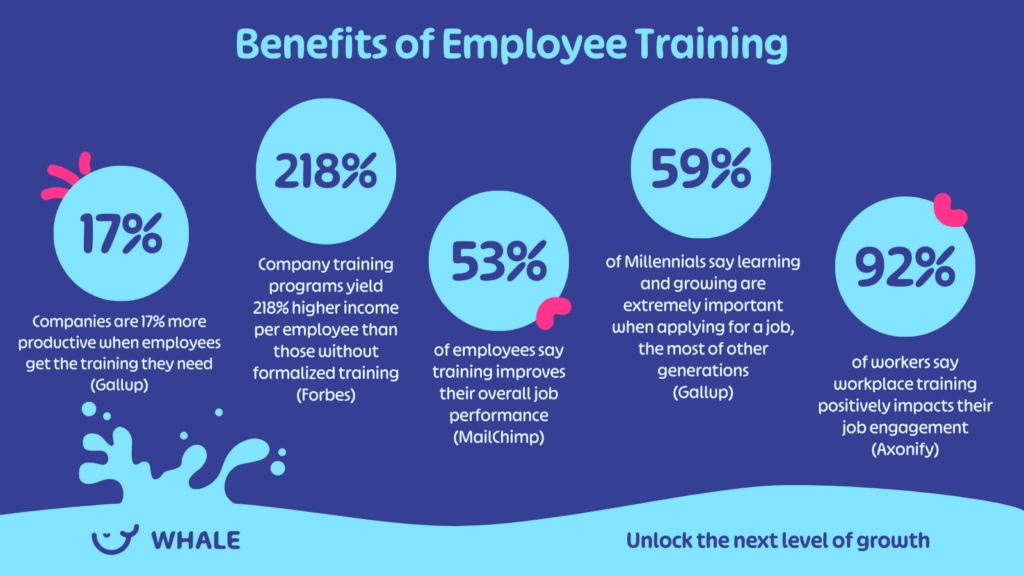Introduction
Everyone knows that training your employees is beneficial to helping them succeed while on the job.
But what if we told you that there were a whole host of other benefits of employee training to your team AND business? 👀
We spoke to a few experts on the benefits they’ve experienced.
Training for employees: 10 advantages & why it's important
- Companies are 17% more productive when employees get the training they need (Gallup).
- Company training programs yield 218% higher income per employee than those without formalized training (Forbes).
- 53% of employees say training improves their overall job performance (MailChimp).
- 59% of millennials say learning and growth opportunities are extremely important when applying for a job (Gallup).
- 92% of workers says workplace training positively impacts their job engagement (Axonify).
Still wondering why an employee training program is important?
By prioritizing training initiatives and facilitating access to knowledge, an organization effectively communicates its core values and priorities. This leaves employees feeling valued.
As a result, when organizations invest resources into employee training, they see a significant return on their investment such as increased individual AND company performance.
As if this wasn’t reason enough, here are 10 additional benefits of employee training that you might not have considered;
1. Training programs for employees reduces workplace stress
The American Institute of Stress report stated that 80% of workers feel stressed on the job.
But why?
Workplace stress can result from unclear job responsibilities to problems with coworkers to not knowing how best to complete a task.
A surprising benefit of employee training is reducing employees’ stress levels and even burnout. Anxiety levels are lower among workers who are certain of their duties and responsibilities and feel confident in them.
A person who is trained and developed to their full potential is more likely to feel empowered to perform their tasks, thus minimizing the risk of stress.
2. Training creates brand ambassadors
Everyone wants employees who love their jobs so much they advocate for you without being asked.
Our very own Stijn Smet (Stino) is just one example.
He’s not only used Whale to make sure Whale has been featured as a leader on G2. But he keeps using his knowledge to teach others.
The more you empower team members with tools and knowledge, the more you enable them to grow. The more they grow, the more likely they are to share your great story with the world and become true brand ambassadors.

3. Encourages stronger team dynamics
Another benefit of ongoing employee training is creating stronger team dynamics. 💪
“Employee training for us has done more than just improve skills; it has significantly strengthened our team dynamics.
By understanding each other’s roles and skills better, our team members collaborate more effectively, leading to enhanced productivity and a more cohesive work environment.
This improved communication and team spirit have been crucial in achieving our business goals and maintaining a positive workplace atmosphere.” – Phil Strazzulla, Founder of SelectSoftware Reviews
4. Helps employees serve customers better
Of course, you train your employees to excel in their roles, which will, in some way, impact your customers. However, training your employees can directly impact customer satisfaction, depending on your business model.
Employees who are well-trained and equipped with the skills and knowledge will feel confident. As a result, they provide excellent service because they can better understand and meet customer needs, leading to improved communication, faster problem resolution, and increased overall satisfaction.
“Employee training has notably improved our sales performance. Through advanced training programs, our sales team has become more adept at understanding customer needs and tailoring their approaches accordingly.” Ian Sells, CEO of Million Dollar Sellers
5. Employee training increases employee retention
Investing in employee training can improve retention rates for top talent.
Whilst the great resignation may be over, in November of 2023 alone, there were 3.5 million people who voluntarily quit their jobs, according to the U.S. Bureau of Labor. So, it goes without saying that encouraging employees to stick around is a high priority for most companies. Luckily, it’s an employee training benefit that many have personally experienced.
According to a study by the Society for Human Resource Management (SHRM), companies that prioritize employees’ professional development programs experience a significant 30% higher retention rate compared to those that do not.
6. Taps into employees’ creative thinking
An employee training benefit that companies have repeatedly said they experienced but didn’t expect was how it positively impacted their staff’s creative thinking skills.
Michael Alexis, CEO of teambuilding.com, says that learning promotes innovation and creativity.
“From my personal perspective as a CEO, one unexpected benefit of employee training that I’ve personally seen and experienced is heightened creativity and innovation in the workplace.
When our employees participate in specialized training programs or workshops, it opens up their minds to new ideas and techniques.
This was particularly evident when we sent a member of our marketing team members to a design thinking workshop. Upon their return, they brought back fresh perspectives on problem-solving and started incorporating more creative approaches into their work.
The unexpected result was an increase in brainstorming sessions that led to innovative solutions for our clients’ needs. It not only enhanced the overall quality of our services but also empowered employees through the realization that their contributions matter greatly to the company’s success.
7. Boosts workplace morale
A survey by Gallup found that only 1/3 of the workforce is engaged at work. And since morale and engagement are connected to retention, it’s safe to say that low morale can also contribute to low engagement rates and, ultimately, to higher staff turnover.
Workplace learning is a sure path to happiness and there are multiple studies that demonstrate the relationship between learning and thriving.
When people work in organizations that offer them access to learning, they are more likely to be motivated and engaged.
8. Creates collective learning and knowledge sharing
Training helps learners gain new skills. Relevant, effective, and accessible training encourages collaboration and knowledge sharing. This happens when learners apply this information to their workplace processes.
This way, when one team member learns a skill, the whole team benefits.
9. Employee training improves organizational processes
Employee training plays a pivotal role in enhancing organizational processes by equipping employees with the necessary skills, knowledge, and tools to perform their tasks efficiently and effectively. Through targeted training programs, employees gain a deeper understanding of their roles within the organization, become proficient in utilizing new technologies or methodologies, and develop problem-solving abilities that enable them to address challenges more adeptly.
As employees become more proficient in their roles, they contribute to streamlining processes, reducing errors, and increasing productivity, ultimately leading to improved organizational performance and competitiveness in the market.
10. Employee training also improves company innovation and resilience
How to choose the right learning methods?
Selecting the right learning methods is pivotal to the success of your learning strategy. With a myriad of options available, from traditional classroom settings to online platforms, understanding the pros and cons of each method ensures that your approach is effective, engaging, and tailored to the needs of your workforce. Here’s how to navigate the selection process:
E-Learning Platforms (like Whale): Digital learning platforms offer flexibility, allowing employees to learn at their own pace and on their own time. Incorporate interactive modules, videos, and quizzes to enhance engagement. Ideal for technical skills and compliance training, e-learning is scalable and cost-effective for large organizations.
Workshops and Seminars: For topics that benefit from interactive discussion and hands-on practice, such as leadership skills or team-building, workshops and seminars provide a dynamic learning environment. They foster collaboration and allow immediate feedback.
On-the-Job Training: Practical experience is invaluable. On-the-job training pairs employees with mentors or uses real-world projects as learning opportunities. This method is highly effective for skills that require practice and nuance, offering immediate applicability.
Blended Learning: Combining online learning with traditional classroom methods, blended learning offers the best of both worlds. It allows for self-paced study along with the benefits of face-to-face interaction and practical application.
Microlearning: Short, focused learning sessions can be highly effective for busy employees. Microlearning delivers content in small, specific bursts, ideal for skill refreshers or quick learning on new topics. It fits easily into the workday without overwhelming learners.
Social Learning: Encourage knowledge sharing within the organization through forums, discussion groups, and peer coaching. Social learning leverages the collective knowledge of the workforce, promoting a learning culture.
Customized Learning Paths: Tailor learning paths for individual roles or career trajectories. Customized paths ensure that learning is relevant and aligned with career development goals, increasing motivation and engagement.
The benefits of software for employee training and development?
Workplace training is essential. But what if you could scale learning within your team simply by utilizing software for employee training?
Employee training software streamlines and automates the learning process, enhancing efficiency, consistency, and scalability.
Software provides employees with accessible, on-demand training materials, tracks their progress, and offers real-time feedback, leading to improved knowledge retention, skills development, productivity, and overall performance.
With employee training software, employees can…
- Go through the material at their own pace.
- Learn anytime, anywhere.
- Access learning they need most.
All of this means less stress. More engagement. And generally happier, more engaged team members.
Employee training software also gives businesses a way not only to engage and retain talent better but also to track the result of learning.
FAQs of employee training
What are the advantages of training to the employees?
There are a host of employee training benefits that favor the business but what are the benefits to the employees? Advantages of training employees include general confidence, increased career opportunities, better job satisfaction, increased personal growth, and a greater ability to adapt to change.
What is the most valuable part of employee training?
Employee training empowers individuals with the knowledge, skills, and tools necessary to excel in their roles and contribute effectively to the organization’s success. Training provides employees with the opportunity to continuously learn and develop, enabling them to stay relevant in their fields, adapt to changing environments, and innovate within their roles.
Not just that but employee training acts as a flywheel for company growth tool. When adopted into company processes, learning acts as a catalyst for growth.
What are the tangible benefits of training?
When we speak of tangible benefits, we talk about training benefits that can be measured. This includes
- Increased Productivity: Well-trained employees are more proficient in their tasks, leading to higher productivity levels and output within the same time frame.
- Faster employee ramp-up time: Training programs expedite the onboarding process for new hires, enabling them to become productive more quickly and reducing the time and resources required for initial training.
- Improved Quality and fewer errors: Training ensures that employees understand and adhere to best practices, resulting in fewer errors, defects, and rework, thereby enhancing the quality of products or services delivered.
- Cost Savings: Reduced errors and increased efficiency resulting from training can lead to cost savings in terms of lower waste, decreased rework, and improved resource utilization.
- Enhanced Customer Satisfaction: Employees who receive thorough training are better equipped to meet customer needs, resolve issues promptly, and provide a superior level of service, leading to increased customer satisfaction and loyalty.
- Reduced Turnover: Investing in employee training demonstrates a commitment to their
- Reduced Turnover: Investing in employee training demonstrates a commitment to their development and growth, leading to higher job satisfaction, morale, and retention rates, thereby reducing turnover costs associated with recruitment and training new employees.
How does training and development in HRM affect employee performance?
Employee performance is defined as how well a person executes their job duties and responsibilities. Training and development not only allows employees to complete tasks more efficiently and, therefore, take less time, but it also allows employees to complete tasks more effectively. They may consider different ways to reach the same goal in less time, or they may learn new skills that allow them to reach beyond their goals as a high performer.
Bottom line?
As you can see, employee training and development is more than “just something to improve knowledge and overcome the forgetting curve.”
Employee training can directly impact a company’s culture, company processes, and even company security. However training is mutually beneficial and also impacts employees’ engagement levels at work and career trajectory.
If you want to start experiencing the benefits of training your employees with a dedicated tool, then sign up for Whale today.










